
The Hawker Harrier was a British experimental biplane torpedo bomber aircraft built by Hawker Aircraft to a specification issued in the 1920s for the Royal Air Force.

The Blackburn Shark was a carrier-borne torpedo bomber designed and built by the British aviation manufacturer Blackburn Aircraft. It was originally known as the Blackburn T.S.R., standing for "torpedo-spotter-reconnaissance", in reference to its intended roles. The Shark was the last of Blackburn's biplane torpedo bombers.

The Blackburn B-5 Baffin biplane torpedo bomber designed and produced by the British aircraft manufacturer Blackburn Aircraft. It was a development of the Ripon, the chief change being that a 545 hp (406 kW) Bristol Pegasus I.MS radial engine had replaced the Ripon's Napier Lion water-cooled inline engine.

The Fairey Hendon was a British monoplane, heavy bomber of the Royal Air Force, designed by Fairey Aviation in the late 1920s. The aircraft served in small numbers with one squadron of the RAF between 1936 and 1939. It was the first all-metal construction low-wing monoplane to enter service with the RAF.
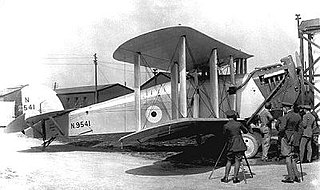
The Blackburn Dart was a carrier-based torpedo bomber biplane aircraft, designed and manufactured by the British aviation company Blackburn Aircraft. It was the standard single-seat torpedo bomber operated by the Fleet Air Arm (FAA) between 1923 and 1933.
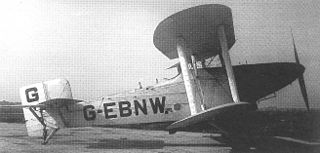
The Avro 571 Buffalo was a prototype British carrier-based torpedo bomber biplane, designed and built by Avro in the 1920s. It was not selected for service, the Blackburn Ripon being ordered instead.
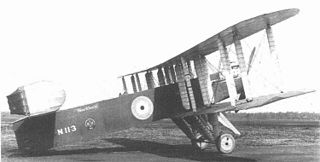
The Blackburn Blackburd was a British prototype single-engine torpedo bomber developed by Blackburn Aircraft in 1918 as a replacement for the Sopwith Cuckoo. It was unsuccessful, only three being built.
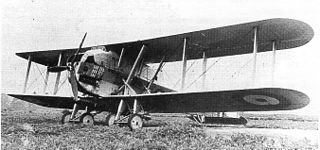
The Blackburn T.4 Cubaroo was a British prototype biplane torpedo bomber of the 1920s. Built by Blackburn Aircraft and intended to carry a large 21 in (533 mm) torpedo, the Cubaroo was claimed to be the largest single-engined aircraft in the world at the time of its first flight.

The Avro Type 557 Ava was a British twin-engined biplane torpedo bomber of the 1920s. It was developed by Avro to meet a requirement for a heavy torpedo bomber for the Royal Air Force but was unsuccessful, only two prototypes being built.

The Handley Page HP.34 Hare was a British two-seat high-altitude day bomber designed and built at Cricklewood by Handley Page. It was designed by Harold Boultbee to meet the requirements of Air Ministry Specification 23/25 for a replacement for the Hawker Horsley in the day bomber role, competing against the Blackburn Beagle, Hawker Harrier, Gloster Goring and Westland Witch. The Hare was a conventional biplane, with single-bay unequal-span staggered wings, of mixed wood and metal construction. It had a crew of two with the pilot in an open cockpit aft of the wing with a gunner/bomb aimer behind him.

The Handley Page Hanley was a British torpedo bomber aircraft of the 1920s. A single-engine, single-seat biplane intended to operate from the Royal Navy's aircraft carriers, it was not successful, with only three aircraft being built.
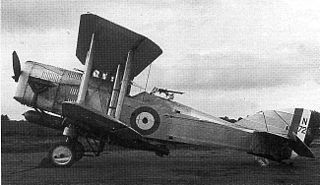
The Handley Page Hendon was a British torpedo bomber of the 1920s. A two-seat development of Handley Page's earlier single-seat Hanley, the Hendon was a single-engine biplane. While six aircraft were purchased by the British Air Ministry for evaluation and trials purposes, no further production ensued and the Hendon did not enter squadron service.

The Blackburn T.R.1 Sprat was a British single-engine two-seat biplane trainer, built in 1926 for advanced training, deck-landing and seaplane experience. Just one was built.

The Blackburn 2F.1 Nautilus was a British single-engine two-seat biplane spotter/fighter built in 1929. Only one was completed.

The Blackburn B.T.1 Beagle was a British single-engine, two-seat biplane bomber/torpedo aircraft from 1928. Designed to Air Ministry specifications which led to no contracts for any manufacturer, only one Beagle was built.

The Gloster Goring was a single-engined two-seat biplane designed to meet 1926 Air Ministry specifications for a day/torpedo bomber. It was not put into production and the one aircraft built served later as an engine testbed.

The Vickers Type 207 was a single-engined two-seat biplane designed as a shipborne torpedo bomber to an early 1930s specification. Structurally innovative, only one was built.
The Handley Page H.P.46 was a two-seat, single-engined biplane built to an Air Ministry specification for a carrier-based torpedo bomber. With an advanced combination of high lift, slow flying controls it was beset by handling problems and made few flights.

The Handley Page H.P.31 was a two-seat single-engined biplane built to a British specification for a carrier-based torpedo bomber and reconnaissance aircraft. After trials, the Blackburn Ripon was preferred, though the Harrow played a significant role in the development of automatic slots.
The Blackburn F3 was a British single-engined fighter aircraft produced in response to Air Ministry Specification F.7/30.


















